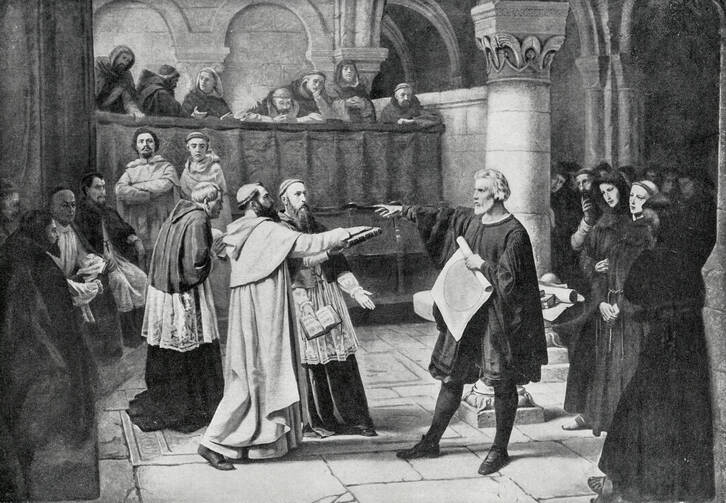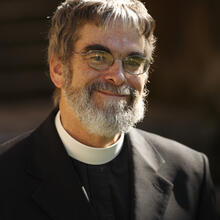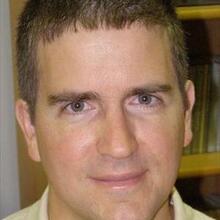Everyone is familiar with the legend of Galileo: how one of the great astronomers in history bravely stood up to the Inquisition in defense of his argument that the earth orbited the sun, rather than vice versa. In recent variations of this myth, the Catholic Church has been cast in the role of science deniers who used Scripture as a cudgel to deny Galileo’s claims and found him guilty of heresy.
Part history, part science fiction, that Galileo story is less a legend than a myth. It claims to explain what happened 400 years ago, and it looks to a future where such mistakes can never happen again. But the stories we tell ourselves are never really about the past or the future; they are about the times in which they are written. The Galileo myth reflects how we understand science and history, church and mythology in our present times of social strife and the Covid-19 pandemic.
Part history, part science fiction, that Galileo story is less a legend than a myth.
Consider a key character in the Galileo story: the Grand Duchess Christina of Lorraine. A descendent of the French royal family, she was the widow of the Medici Grand Duke Ferdinand I of Tuscany and the mother of Cosimo II, who ruled Tuscany in the 1610s. Galileo came from Tuscany, and Ferdinand gave Galileo his first teaching job; Galileo tutored Cosimo in math, and Cosimo made Galileo his official court philosopher and mathematician.
In December 1613, the grand duchess, a devoutly religious woman, asked Galileo’s friend, the Benedictine monk Benedetto Castelli, about the things Galileo had discovered with his telescope and his support for Nicolas Copernicus’s idea that the Earth, not the sun, moved. To her that seemed contrary to certain biblical verses; Eccl 1:5, for example, says, “The sun rises and the sun sets; then it presses on to the place where it rises.” Castelli, though intimidated by the prospect of arguing with royalty, politely and respectfully defended the idea of a moving Earth.
The Galileo myth reflects how we understand science and history, church and mythology.
We know all this because Castelli described it to Galileo in a letter dated Dec. 14, 1613. Galileo responded with a letter back to Castelli a week later and after that with a longer letter to Christina herself. These letters have come to be known as masterly discussions of science and religion, full of statements like “Holy Scripture and nature both equally derive from the divine Word, the former as the dictation of the Holy Spirit, the latter as the most obedient executrix of God’s commands.”
But they were words about religion, a topic where Galileo had neither formal training nor church remit to teach. In 1615, the letter to Castelli became the subject of a complaint lodged against Galileo with the Inquisition. The Galileo story, full of religious politics, personality and pettiness, was off and running.
Was Christina then a science denier? Did she and those like her reject science for Scripture? Actually, no.
Compelling Scientific Reasons
Note that Galileo responded to Christina not through scientific arguments but by focusing on the Bible. That is because Christina did not disagree with the science. She granted to Castelli that everything Galileo had discovered was true. After all, by April 1611 a team of Jesuit astronomers had verified Galileo’s discoveries, discoveries that showed that Jupiter had moons circling it, that Venus circled the sun and so on.
There is a problem with seeing the Galileo story as a narrative of the church denying science. It implies that science is a single, monolithic worldview.
The trouble was that moons circling Jupiter or Venus circling the sun did not show that the Earth moved. Those discoveries were fully compatible with the ideas of Tycho Brahe, the most capable astronomer of the previous generation. Brahe envisioned the sun, moon and stars circling an immobile Earth, while the planets circled the sun. Brahe’s and Copernicus’s systems were identical when it came to observations involving the sun, moon and planets.
But there is a more subtle problem with seeing the Galileo story as a narrative of the church denying science. It implies that science is a single, monolithic worldview based on unchanging facts that can be objectively proved. But consider Brahe. He admired Copernicus and his work, yet he argued against Copernicus. He did so based not on the Bible but on what we can recognize today as compelling scientific grounds.
Look at the Stars
For one thing, the physics of the time, the geocentric physics of Aristotle, explained the motions of celestial bodies by assuming they were made of a mysterious, lightweight “quintessence,” not found on Earth, that naturally stayed up in the heavens and moved in circles. By contrast, earthly things were heavy and naturally tended to rest. There was no physical explanation for how a heavy Earth might move forever around the sun. (Newton’s laws of motion were still decades in the future.)
A second compelling argument for Brahe’s system was the size and position of the stars. If the Earth were moving, then its motion relative to the stars should have been detected. Brahe had himself observed stars with remarkable and accurate precision; he had detected nothing. So either the Earth did not move, or the stars were so distant that Earth’s orbit was nothing by comparison. But how could anyone tell?
Astronomers at that time thought Galileo’s new telescope could give them the answers. They thought they could measure the apparent sizes of stars because, as Galileo claimed, the telescope was capable of “showing the disc of the star bare and very many times enlarged.” And then, assuming those stars were the same size as the planets or the sun, they could calculate their distance from the Earth.
Astronomers at that time thought Galileo’s new telescope could give them the answers. But no one at the time understood the subtleties of telescopes.
The German astronomer Simon Marius, measuring the disks that he saw in his telescope, did the calculation and wound up endorsing Brahe’s system, not Copernicus’s. So did the Jesuit astronomer Christoph Scheiner, who noted that if the orbit of the Earth cannot be detected in a heliocentric universe but the size of a star can be, then the star must be larger than that orbit. Every observable star would have to be larger, utterly dwarfing the sun and every other celestial body. In Brahe’s geocentric system, by contrast, the sizes of stars compared nicely to other celestial bodies.
The problem was that no one at the time understood the subtleties of telescopes. Telescopes focus imperfectly. What should be a point of light in a telescope winds up looking like a fuzzy spot. That spot was what astronomers, including Galileo, were measuring. A full understanding of telescopes and the relative motion of the stars would not be achieved until the 19th century.
Rising (and Falling) Tides
A third scientific argument against the Earth’s motion was that a falling object should not drop straight down but should appear to be slightly deflected if the ground to which it falls is part of a spinning Earth. That tiny effect was first suggested by Jesuit scientists of Galileo’s time. Today, it is understood to be a key factor in weather patterns, and it is called the Coriolis effect, after a 19th-century scientist. The Jesuits, understandably unable to detect it, argued that its absence suggested the Earth’s immobility.
Galileo’s letters to Castelli and Christina said little to those who were drawn to Brahe’s ideas for scientific reasons such as these. Instead, Galileo would provide a scientific argument for Earth’s motion in the 1616 essay “On the Tides” and in his famous 1632 book Dialogue on the Two World Systems, which eventually led to his trial.
In these two writings, Galileo claimed that Earth’s double motion of rotation about its own axis plus its revolution about the sun sloshed the oceans back and forth daily in their basins, generating the tides. But this action alone could not explain the Mediterranean tides, which occur twice daily. To this, Galileo argued that the tidal periods in different places were determined by local characteristics that reflected the water surge back and forth within the local basin. Thus, the twice-daily tides were characteristic of the Mediterranean only.
When churchmen or a royal woman argued against Galileo, they were not denying science. They had science on their side.
In his 1616 essay, Galileo claimed that the Atlantic Ocean’s tides observed in Lisbon, Portugal, occurred once daily, in agreement with his theory. In 1619, however, Galileo was informed (by Richard White of England) that this claim was in error; tides are twice daily at Lisbon, too. That should have proved Galileo’s theory false. Yet in 1632, Galileo presented it again, with a key change to his argument from 1616: He omitted all mention of the Atlantic tides.
Galileo’s scientific argument was fallacious. The science of the day—the observable evidence, the most correct reasoning—was against him and his theory. And his opponents knew that. Francesco Ingoli, a Theatine priest, who played a role in the church’s censoring of Copernicus’s work in 1616, cited the star-size problem and the problem of falling bodies. Melchoir Inchofer, S.J., who played a role in the rejection of the Dialogue, noted the star-size problem; the Rev. Zaccaria Pasqualigo, also involved in that rejection, noted the issue of tidal periods. Thus when churchmen or a royal woman argued against Galileo, they were not denying science. They had science on their side.
Nevertheless, as we know now, they were wrong.
The Nature of Science
That is not to say that Galileo was ultimately proved “right.” What gives the Galileo myth its infamy is that it is supposedly about “science” and “facts” versus powerful people attacking “Truth.” But no one today views the universe as Galileo did. The Earth may not be the center of the universe, but neither is the sun; it is just one star in a galaxy of stars, which, in turn, is one among a universe of galaxies. And today’s understanding of the universe is barely 100 years old and comes with its own mysterious “quintessences,” like “dark matter” and “dark energy.” Who knows how science will describe the universe 100 or 400 years from now? Any Galileo story that ends with a triumphant finality misunderstands the nature of science itself.
No one today views the universe as Galileo did. The Earth may not be the center of the universe, but neither is the sun.
Furthermore, such a story misses the very things about Galileo that made him great: his wider vision; the artistic talent that allowed him to see and intuit the truth even if incompletely; his mathematical ability to ask the right questions and suggest ways of searching for answers; his genius for communicating his ideas to a broad and influential audience.
But just as we must recognize that science is neither monolithic nor always right, we also should be wary of treating the other side of this equation, the church, as if it, too, were a single entity speaking with a single voice. Even in Galileo’s time, many clergymen (like Castelli) argued his side. Indeed, one of the fascinating puzzles of the whole story is that for many years it seemed that Pope Urban VIII, who would be the driving force behind Galileo’s trial, was himself a Galileo man.
Galileo’s story is certainly not one of church versus science. But Galileo’s trial was indeed a terrible injustice. Historians debate the root of that injustice. Some blame the personalities involved. Others cite the political and economic pressures involving the Holy See and the wealth of the Medici family, represented by Grand Duchess Christina. Still others cite the upheaval of the Thirty Years War, which reached its peak during the time of Galileo’s trial. All these pressures were real. None justified a heresy trial.
And let’s face it: On the scale of things that the church gets wrong, the Galileo story is competing with many other sins that are always before us. To cite but one example: A generation after Galileo, Jesuit priests in Maryland would own slaves. That racism infects society even today.
We study what happened in history to imagine a better future. That is the immediate relevance of the Galileo story to us today. But we must be careful that the stories we tell ourselves do not fit too neatly into contemporary stereotypes like “science denialism.” If we do not diagnose problems correctly, we cannot come up with good solutions. You do not treat Covid-19 as if it were the flu. You do not treat systemic racism as if it were merely an economic issue. You do not treat the mistakes the church made with Galileo by assuming it was due to science-denial in the church. And you do not treat the problem of science-denial today through the fiction that it was at the root of the Galileo story.
Editor’s note: The authors write for the Vatican Observatory Foundation’s blog, “Sacred Space Astronomy,” where many of the ideas in this article were first developed.










